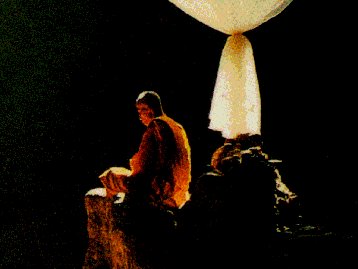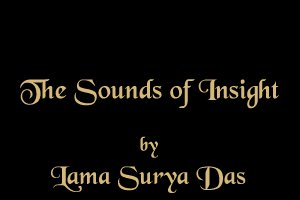 In creation stories the world over, sound is often a leading character--primordial and omnipresent, existing even before the world itself, linking us together even now. As Sufi master Hazrat Inayat Khan explains in "The Mysticism of Sound and Music," "Before the world was, all was in sound. God was in sound, we are made of sound." The gospel of John says, "In the beginning was the Word, and the Word was with God, and the Word was God." Everything stems from, is interconnected by, and returns to vibration, which is pure energy. Sound is vibration. Sound has tremendous power.
In creation stories the world over, sound is often a leading character--primordial and omnipresent, existing even before the world itself, linking us together even now. As Sufi master Hazrat Inayat Khan explains in "The Mysticism of Sound and Music," "Before the world was, all was in sound. God was in sound, we are made of sound." The gospel of John says, "In the beginning was the Word, and the Word was with God, and the Word was God." Everything stems from, is interconnected by, and returns to vibration, which is pure energy. Sound is vibration. Sound has tremendous power.
 One of the most transformative and nonsectarian spiritual practices, chanting almost immediately takes us out of our heads and beyond the mind, into realms of pure spirit and bliss. It helps us discover the spiritual breath and cosmic energy (prana in Sanskrit) inside the physical breath. Monks and nuns, shamans, yogis, dervishes, chant masters, pilgrims, cantors, singers, and musicians have long known this universal secret. "Chant is the music of the cosmic spheres and the natural expression of higher consciousness," says Don Campbell, musician and author of "The Mozart Effect." Chant is not an obscure ritual--it is the important tool used by people everywhere to heal their bodies, quiet their minds, and bring the sacred into their lives."
One of the most transformative and nonsectarian spiritual practices, chanting almost immediately takes us out of our heads and beyond the mind, into realms of pure spirit and bliss. It helps us discover the spiritual breath and cosmic energy (prana in Sanskrit) inside the physical breath. Monks and nuns, shamans, yogis, dervishes, chant masters, pilgrims, cantors, singers, and musicians have long known this universal secret. "Chant is the music of the cosmic spheres and the natural expression of higher consciousness," says Don Campbell, musician and author of "The Mozart Effect." Chant is not an obscure ritual--it is the important tool used by people everywhere to heal their bodies, quiet their minds, and bring the sacred into their lives."
 Chanting involves the body, mind, and spirit; it utilizes intention, concentration, the breath, the heartbeat, chest, lungs, voice, tongue, mouth--our entire being. It is both relaxing and therapeutic, while providing direct access to meditative states and higher realms of subtle spiritual experience. It awakens our energy and can stimulate energetic and spiritual breakthroughs. It helps us open our throat and heart chakras and access the inexhaustible treasury of awareness and wisdom to be found there.
Chanting involves the body, mind, and spirit; it utilizes intention, concentration, the breath, the heartbeat, chest, lungs, voice, tongue, mouth--our entire being. It is both relaxing and therapeutic, while providing direct access to meditative states and higher realms of subtle spiritual experience. It awakens our energy and can stimulate energetic and spiritual breakthroughs. It helps us open our throat and heart chakras and access the inexhaustible treasury of awareness and wisdom to be found there.
 I have had some of my most moving spiritual experiences while chanting for hours at a time, especially on Tibetan Buddhist retreats where we chanted an average of eight to 10 hours a day, and on high holidays, when chanting can go on for as many as 24 hours at a time, seven days in a row (and even more) without stopping. If that does not change your consciousness, nothing will!
I have had some of my most moving spiritual experiences while chanting for hours at a time, especially on Tibetan Buddhist retreats where we chanted an average of eight to 10 hours a day, and on high holidays, when chanting can go on for as many as 24 hours at a time, seven days in a row (and even more) without stopping. If that does not change your consciousness, nothing will!
 Tibetan Buddhism is renowned for the use of mantras, chants, and esoteric liturgies and rituals as an essential part of its tantric meditation and yoga system. In fact, Tibetan Buddhism is more properly known as 'Secret Mantra Vajrayana,' or the Diamond Vehicle of Secret Mantras. Chanting is used extensively for blessing, worship, communion, and healing, as well as for meditation, concentration, and purification. Mantra meditation can totally transform the atmosphere and effect swift transformation, both internally and externally.
Tibetan Buddhism is renowned for the use of mantras, chants, and esoteric liturgies and rituals as an essential part of its tantric meditation and yoga system. In fact, Tibetan Buddhism is more properly known as 'Secret Mantra Vajrayana,' or the Diamond Vehicle of Secret Mantras. Chanting is used extensively for blessing, worship, communion, and healing, as well as for meditation, concentration, and purification. Mantra meditation can totally transform the atmosphere and effect swift transformation, both internally and externally.
 Mantras are words of sacred power, pregnant with meaning and resonance. According to my late teacher, the great Tibetan lama Deshung Rinpoche, the word "mantra" literally means 'something to lean the mind/consciousness upon.' The Buddha himself said, "Better than a meaningless story of a thousand words is a single word of deep meaning which, when heard, produces peace." The mantra OM is one example of such a word, redolent with peace; when intoned, it naturally lends itself to harmony, oneness, and unity.
Mantras are words of sacred power, pregnant with meaning and resonance. According to my late teacher, the great Tibetan lama Deshung Rinpoche, the word "mantra" literally means 'something to lean the mind/consciousness upon.' The Buddha himself said, "Better than a meaningless story of a thousand words is a single word of deep meaning which, when heard, produces peace." The mantra OM is one example of such a word, redolent with peace; when intoned, it naturally lends itself to harmony, oneness, and unity.
 There are numerous kinds of mantras: wisdom mantras, healing mantras, peaceful mantras, wrathful mantras, magnetizing mantras, transforming mantras, fire mantras, earth mantras, sky mantras, wind mantras, deity mantras, spirit mantras, obstacle-removing mantras, ego-destroying mantras, and so on. But donít be confused by the variety: "Though mantras may be used for a variety of ends, their highest purpose is to assist the mantra-practitioner in coming face to face with his own divinity. By comparison, all other ends are trivial," wrote the late Buddhist scholar John Blofeld.
There are numerous kinds of mantras: wisdom mantras, healing mantras, peaceful mantras, wrathful mantras, magnetizing mantras, transforming mantras, fire mantras, earth mantras, sky mantras, wind mantras, deity mantras, spirit mantras, obstacle-removing mantras, ego-destroying mantras, and so on. But donít be confused by the variety: "Though mantras may be used for a variety of ends, their highest purpose is to assist the mantra-practitioner in coming face to face with his own divinity. By comparison, all other ends are trivial," wrote the late Buddhist scholar John Blofeld.
 One of my favorite mantras is the mantra of love and compassion, Om Mani Pedmay Hung, which literally means 'the jewel is in the lotus' or 'the Buddha is within.' This is the Dalai Lamaís mantra, and the national mantra of Tibet.
One of my favorite mantras is the mantra of love and compassion, Om Mani Pedmay Hung, which literally means 'the jewel is in the lotus' or 'the Buddha is within.' This is the Dalai Lamaís mantra, and the national mantra of Tibet.
 Mantras can be orally chanted, intoned, or even sung. They can also be repeated mentally to oneself. Secretly, they can be visualized in the inner chakras and energy channels of the 'light body' (subtle body), or aid in deep samadhi (meditative absorption). Mantra repetition is classically one of the most surefire methods to train the attention and to learn concentration, focus, and how to calm the mind.
Mantras can be orally chanted, intoned, or even sung. They can also be repeated mentally to oneself. Secretly, they can be visualized in the inner chakras and energy channels of the 'light body' (subtle body), or aid in deep samadhi (meditative absorption). Mantra repetition is classically one of the most surefire methods to train the attention and to learn concentration, focus, and how to calm the mind.
 You can easily learn the chants I practice and do them yourself. Donít feel shy or self-conscious--nobodyís listening! When I was young, my music teacher used to tell me to stand in the back and mouth the words, because I couldnít sing. But when I was in India and trained in chanting, I felt my throat chakra open, and I lost my self-consciousness. I didnít care what it sounded like, because it was a practice. Sometimes I chant while I walk or drive, or I listen to chant CDs along the way. We all need a little more music in our souls. I never leave home without it.
You can easily learn the chants I practice and do them yourself. Donít feel shy or self-conscious--nobodyís listening! When I was young, my music teacher used to tell me to stand in the back and mouth the words, because I couldnít sing. But when I was in India and trained in chanting, I felt my throat chakra open, and I lost my self-consciousness. I didnít care what it sounded like, because it was a practice. Sometimes I chant while I walk or drive, or I listen to chant CDs along the way. We all need a little more music in our souls. I never leave home without it.
 Mechtild of Magdeburg, a 13th-century Catholic lay sister, wrote:
Mechtild of Magdeburg, a 13th-century Catholic lay sister, wrote:
 "As the Godhead strikes the note, humanity sings.
"As the Godhead strikes the note, humanity sings.
 The Holy Spirit is the harpist, and all the strings must sound which are touched by love."
The Holy Spirit is the harpist, and all the strings must sound which are touched by love."
 Lama Surya Das
Lama Surya Das
Dzogchen Organization
Belief Net
The Spirit of The Human Voice
Back to Apprentice Weavers
|

